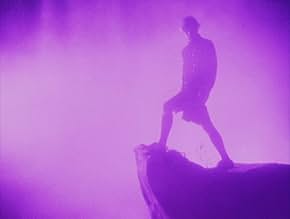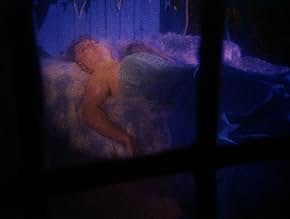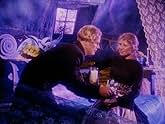IMDb-BEWERTUNG
7,0/10
1994
IHRE BEWERTUNG
Füge eine Handlung in deiner Sprache hinzuThe wary residents of a 19th century mountain village must tread carefully and speak softly lest they cause an avalanche. Sexual frenzies teem in this world of repression, setting off incest... Alles lesenThe wary residents of a 19th century mountain village must tread carefully and speak softly lest they cause an avalanche. Sexual frenzies teem in this world of repression, setting off incestuous love triangles with deadly consequences.The wary residents of a 19th century mountain village must tread carefully and speak softly lest they cause an avalanche. Sexual frenzies teem in this world of repression, setting off incestuous love triangles with deadly consequences.
- Auszeichnungen
- 1 wins total
Andrea Von Wichert
- Townsperson
- (as Andrea Wichert)
Empfohlene Bewertungen
If you are a fan of German Expressionism, then you will enjoy this modern homage to a beautiful and arresting style perceived and captured wonderfully by Guy Maddin. There is a ton of symbolism and exploration of the sexual taboos found in both the Oedipus and Cassandra complexes of Greek mythology while allowing for quite humorous character developments which certainly make the film that much more enjoyable than just an "art" film. Maddin's use of light and especially color adds to the classic expressionist model which gets a gorgeous injection of modern fare. While I can enjoy the notion of one reviewer calling this a cross between "The Wizard of Oz and Eraserhead", I definately saw this as a much more direct colorful homage to "Caligari" than anything Lynch-esque. There is not the mind-numbing mixture of light and sound which generates its own tension but rather a playful use of sets and characters which surmount to quite a comical time. That is not to say there is not a scene or two that would make a horror fan happy but they are very straight forward and even amusing.
I love Guy Maddin's work and this is my favourite of his films. It's odd and unsettling and it sticks with you long after you've watched it.
It's definitely not the most accessible of his works, but I like it. It's been described as a "pro-repressionist" movie, but I don't think that's entirely accurate.
The people portrayed in the village are deeply repressed and one small push makes their whole stack of cards morals come tumbling down. It's tale of three brothers and their trials and tribulations.
Their father is deceased and one brother, Vince Rimmer as Franz, is an invalid confined to the attic, who can do little more than watch as his brothers are tempted and run amok.
First Brent Neale as Johann, then Kyle McColloch as Grigorss give in to their desires and forbidden longings with tragic consequences. Kyle McColloch is a Maddin regular and he shines here.
Engagements are broken, people have knife fights and their mother is seeking to re-marry.
It's definitely not the most accessible of his works, but I like it. It's been described as a "pro-repressionist" movie, but I don't think that's entirely accurate.
The people portrayed in the village are deeply repressed and one small push makes their whole stack of cards morals come tumbling down. It's tale of three brothers and their trials and tribulations.
Their father is deceased and one brother, Vince Rimmer as Franz, is an invalid confined to the attic, who can do little more than watch as his brothers are tempted and run amok.
First Brent Neale as Johann, then Kyle McColloch as Grigorss give in to their desires and forbidden longings with tragic consequences. Kyle McColloch is a Maddin regular and he shines here.
Engagements are broken, people have knife fights and their mother is seeking to re-marry.
Guy Madden is almost like the David Lynch of Canada. His films have a look all of their own; blending surrealism with German style expressionism. The grainy slightly faded style of his films, make them appear from another era. "Careful" is filmed in a bright Technicolor style that's visually dazzling. The film contains Icelandic folk lore with dark humor. The story concerns a town living in the mountains. They have to watch their every move so they don't cause an avalanche. So they try to keep quiet and not make much noise out of fear. Many of the characters have strange incestuous desires that lead them to insanity. Especially Yohan and his fantasies about his mother. Yuck! This is one strange film, with picturesque landscapes that look like they jumped out of a Salvador Dali painting. If you are looking for a disturbing candy colored dark comedy, careful you don't pass this opportunity up.
Hilariously demented: Take camera work and set design inspired by "The Cabinet Of Dr. Caligari" and the early talkie "Svengali", scenario and dialogue that might have been written by Ibsen (under the influence of peyote), then put a creature from Alpha Centauri doing his first English-language film in the director's chair and you get some idea of what this movie is like.
If there's not something wrong with you, you won't like this movie at all, but there's much here that twisted sensibilities will find appealing. Consider yourself warned.
If there's not something wrong with you, you won't like this movie at all, but there's much here that twisted sensibilities will find appealing. Consider yourself warned.
The USA Film Festival described this as Twin Peaks directed by Erich von Stroheim. Not a bad description. It's an uproarious satire, in the vein of YOUNG FRANKENSTEIN ... but the film often so beautifully duplicates the material it parodies that your breath is taken away. It's a little like reading a hysterical comic book, and finding original paintings by old masters salted throughout!
This brilliant Canadian film heavily borrows from the high-camp expressionism of German silent films and early talkies, especially the "mountain" films of Leni Riefenstahl. Anyone who's read FROM CALIGARI TO HITLER will recognize dozens of scenes in this film as near carbons of stills from the book. Perhaps more than any other films before or since, German silent cinema created compelling images that tap into universal race consciousness, portraying grainy, moving archetypal images all of us vaguely recognize from dreams or nightmares. Because of this, CAREFUL will often take your breath away with unexpected moments of quiet majesty and beauty. But there are plenty of laughs in between, (with "sick," 70's style National Lampoon-like humor). If you've never laughed at seeing an eye poked out, leave political correctness at the door and give this film a whirl!
The soundtrack if often deliberately scratchy or muffled, and in several scenes easter-egg like colors are used that resemble the early two-strip technicolor process. Ominous title cards are used to introduce scenes. This bizarre film is salted with unexpected dialogue like this: BOY: "My, aren't you the frisky one today." GIRL: "Even the reindeer are such, when Spring is coming!"
Enough of the aesthetics, what is the film supposedly about? The action takes place in the 19th century alpine village of Tolzbad, that is so precariously poised under constant threat of avalanche that villagers have learned to communicate only in whispers. Animals have had their vocal chords removed, and gramophones have lambs wool stuffed in the horn. Villagers keep time to the "sound" of silent instruments at a "concert." There are handful of soundproof ice caves where the villagers can frolic and shout, letting out their pent up, pagan passions. The film is clearly a biblical parable about repression. Jackie Burroughs does a brilliant bit part as the puritanical teacher, who closely resembles the Cloris Leachman role in YOUNG FRANKENSTEIN.
All of the characters display a surface naivete; actresses speak in the perky, breathless voices reminiscent of badly dubbed post-war European B films; "strapping" young sons still wear short pants'd school uniforms. The film quickly descends below the surface to show the village as a cauldron of incestuous flirtations, violent retaliation and explosive "family secrets." The plot follows an arc of forbidden loves and passions, leading to retribution on a biblical scale. What may appear to the modern audience as "cheap" special effects are actually loving recreations of how ghosts and visions were portrayed in silent and early talking German films. Many of the images are unforgettable, like the "trolley" cars pulled by oxen, or the mine workers wearing crowns of flickering candles. Uncoated lenses and back lit hair make some closeups resemble images from early Garbo or Dietrich films.
CAREFUL warrants multiple viewings. Watch it with a friend; this is definitely a film you'll want to dissect over several capuccinos.
This brilliant Canadian film heavily borrows from the high-camp expressionism of German silent films and early talkies, especially the "mountain" films of Leni Riefenstahl. Anyone who's read FROM CALIGARI TO HITLER will recognize dozens of scenes in this film as near carbons of stills from the book. Perhaps more than any other films before or since, German silent cinema created compelling images that tap into universal race consciousness, portraying grainy, moving archetypal images all of us vaguely recognize from dreams or nightmares. Because of this, CAREFUL will often take your breath away with unexpected moments of quiet majesty and beauty. But there are plenty of laughs in between, (with "sick," 70's style National Lampoon-like humor). If you've never laughed at seeing an eye poked out, leave political correctness at the door and give this film a whirl!
The soundtrack if often deliberately scratchy or muffled, and in several scenes easter-egg like colors are used that resemble the early two-strip technicolor process. Ominous title cards are used to introduce scenes. This bizarre film is salted with unexpected dialogue like this: BOY: "My, aren't you the frisky one today." GIRL: "Even the reindeer are such, when Spring is coming!"
Enough of the aesthetics, what is the film supposedly about? The action takes place in the 19th century alpine village of Tolzbad, that is so precariously poised under constant threat of avalanche that villagers have learned to communicate only in whispers. Animals have had their vocal chords removed, and gramophones have lambs wool stuffed in the horn. Villagers keep time to the "sound" of silent instruments at a "concert." There are handful of soundproof ice caves where the villagers can frolic and shout, letting out their pent up, pagan passions. The film is clearly a biblical parable about repression. Jackie Burroughs does a brilliant bit part as the puritanical teacher, who closely resembles the Cloris Leachman role in YOUNG FRANKENSTEIN.
All of the characters display a surface naivete; actresses speak in the perky, breathless voices reminiscent of badly dubbed post-war European B films; "strapping" young sons still wear short pants'd school uniforms. The film quickly descends below the surface to show the village as a cauldron of incestuous flirtations, violent retaliation and explosive "family secrets." The plot follows an arc of forbidden loves and passions, leading to retribution on a biblical scale. What may appear to the modern audience as "cheap" special effects are actually loving recreations of how ghosts and visions were portrayed in silent and early talking German films. Many of the images are unforgettable, like the "trolley" cars pulled by oxen, or the mine workers wearing crowns of flickering candles. Uncoated lenses and back lit hair make some closeups resemble images from early Garbo or Dietrich films.
CAREFUL warrants multiple viewings. Watch it with a friend; this is definitely a film you'll want to dissect over several capuccinos.
Wusstest du schon
- WissenswertesRebecca Gibson's debut.
- VerbindungenFeatured in Guy Maddin: Waiting for Twilight (1997)
Top-Auswahl
Melde dich zum Bewerten an und greife auf die Watchlist für personalisierte Empfehlungen zu.
- How long is Careful?Powered by Alexa
Details
Zu dieser Seite beitragen
Bearbeitung vorschlagen oder fehlenden Inhalt hinzufügen












